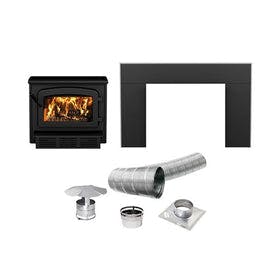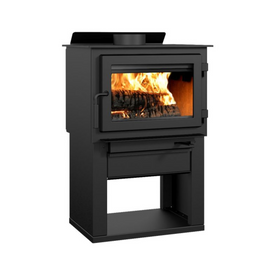
Is Electric Better Than Gas for Homes?
Last Updated: Apr 7, 2025For those of us who grew up in the age of fossil fuel abundance, we might have convinced ourselves that natural gas and propane were essential elements to power and heat our homes. Before the age of renewable energies, using gas to heat our homes and cook our food might have actually made more ecological sense. Coal-fired electricity plants release enormous amounts of greenhouse gas emissions. It takes a lot of coal-powered electricity to heat a poorly insulated home with leaky windows during long, cold winter nights.
Table of Contents
- Is Natural Gas Cleaner Than Coal and Oil?
- What Is Natural Gas Used for Today?
- Why Is Natural Gas Bad?
- What Are The Benefits of All-Electric Homes?
- Is Natural Gas Cheaper Than Electricity?
- What Is the Average Cost of Electricity?
- Will Fossil Fuels Always Be Cheaper?
- The Importance of a Renewable Energy Grid
Is Natural Gas Cleaner Than Coal and Oil?
Natural gas has long been touted as a cleaner energy option to coal and oil—and it is slightly cleaner: the US Energy Information Administration shows that natural gas emits 43% less carbon dioxide per unit of energy than coal. But it is still a non-renewable fossil fuel that emits CO2, methane (a much more potent greenhouse gas than CO2), and nitrogen oxides (NOx), a precursor to smog.

As our sustainable building technologies have advanced, the possibilities for entirely electrifying our homes are growing. Those energy-inefficient baseboard heaters of past decades that led to enormous utility bills have been replaced by high-efficiency heat pumps that can heat homes in a highly efficient fashion. Similarly, the growth of renewable energies combined with the decline in coal-powered electricity means that electrifying our homes will also lead to lower carbon emissions and cheaper utility costs.
Below, we offer a comparison between all-electric and dual-energy homes or homes that rely on both electricity and natural gas. Specifically, we look at some of the most commonly associated benefits that come with all-electric homes and crunch the numbers on which type of home is best for your budget.
What Is Natural Gas Used for Today?
Around 48 percent of homes still rely on propane or natural gas for their primary heating needs. The installation of gas-powered fireplaces has steadily increased in recent years as a comfortable and luxurious secondary heat source. On the other hand, gas cooktop stoves for cooking only account for 11 percent of total natural gas demand in the United States. Today then, the majority of natural gas in homes is used for heating needs within our homes.
Why Is Natural Gas Bad?
Despite industry claims that natural gas is a “clean” fossil fuel, the Energy Information Administration finds that natural gas still emits 117 pounds of CO2 per million British thermal units (Btu) of energy produced. As natural gas deposits grow, ever scarcer, more energy-intensive, and environmentally degrading extraction technologies are being utilized. “Fracking” requires pumping a toxic sludge to fracture the ground rock. The fracking industry has been linked to the massive contamination of groundwater, among other environmental problems.

Also, dual-energy homes that continue to rely on natural gas for heating, cooking, or water heating will never be able to achieve carbon zero status. The burning of fossil fuels inevitably releases carbon dioxide and other greenhouse gasses into the atmosphere. The most recent IPCC report released in October of 2018 states that our world needs to achieve carbon zero status within the next 30 years if we are going to avoid the worst potential effects of climate change. The only way to achieve this is by opting for all-electric homes.
What Are The Benefits of All-Electric Homes?
There are several benefits of opting for all-electric homes, which we will detail below.
- More energy-efficient devices and appliances: electric devices and appliances tend to be much more energy-efficient than their gas-powered counterparts. Convection ranges and stovetops, for example, use much less overall energy for cooking than gas cookers. Similarly, heat pumps are widely considered to be the most energy-efficient way to heat and cool home, while also offering a source of hot water as a byproduct.
- Cheaper energy bills: All electric homes allow homeowners the possibility of enjoying the economic benefits of renewable energies. For homeowners wanting to install residential solar panels, there are financing options available that will allow you to experience savings from day one. Even if you don’t own your home or don’t have a roof where you can place a solar array, participating in a Community Solar program will allow you to enjoy the benefits of cheaper (and cleaner) renewable energy.
- Possibility to move towards zero emissions with the adoption of renewable energies: In the future, our homes are going to have to be net-zero energy(or net-positive energy). Only by eschewing the use of natural gas in our homes will we be able to reduce our total household carbon footprint to zero.
- Easier to integrate electric appliances with smart home technologies: All-electric homes are naturally positioned to make the most out of smart home technologies. Most electric devices and appliances today can be linked home to a central home automation hub that will allow you to even further cash in on energy efficiency-related savings.
Is Natural Gas Cheaper Than Electricity?
Despite the rapid growth of renewable energy technologies, fossil fuels still account for 63 percent of our total electricity production. The abundance of natural gas that is being unearthed by hydraulic fracturing has led to natural gas accounting for 27 percent of the electricity generated in the United States. The reason for its growth is because it is currently the cheapest way to heat a home. According to CenterPoint Energy, one of the largest energy companies in the country, “natural gas prices are consistently two to three times lower than electric prices.”
What Is the Average Cost of Electricity?
The average national price of electricity currently stands at $0.12 per kilowatt-hour (kWh), while the average price per therm for natural gas is $1.05. A central furnace for a home could expect to use around 489 therms per year for a yearly heating cost of about $513. For comparison’s sake, homeowners in mild climates with all-electric homes spend anywhere between 5,000 and 30,000 kWh for heating. Even the low estimate of 5,000 kWh would amount to a $600 annual heating bill, while the higher estimate for poorly constructed and insulated homes could be as high as $3,600.
For homeowners on a tight budget, natural gas is the cheaper option, especially when it comes to heating costs. However, fossil fuel sources of energy should only continue to grow more expensive due to increasing scarcity. Geopolitical factors, proposed carbon taxes as part of the fight against climate change, and growing scarcity as non-renewable resources all point to a substantial likelihood of increasing the price of fossil fuel energies.
Will Fossil Fuels Always Be Cheaper?
As fossil fuel production continues to increases alongside energy consumption, the supply of these fossil fuels will start to diminish. As supply decreases and demand increases, prices will increase accordingly. The slowly but steadily rising cost of electricity also proves this point as residential electricity rates have ballooned by 15% over the last ten years, mainly due to the increased costs of obtaining fossil fuel energy sources.
Renewable sources of energy (especially solar energy), on the other hand, have been steadily dropping in price while increasing efficiency and potency over the past decades.
The Importance of a Renewable Energy Grid
While there are financial benefits and environmental reasons to switch to an all-electric, solar-powered home, it is also worth mentioning that natural gas and other fossil fuels are still the primary sources of the electricity we use in our homes. Homeowners can reduce their carbon footprint by opting for energy-efficient electric heat pumps as their primary heating source. Suppose their municipal supplied electricity comes from the burning of coal or natural gas. In that case, there will still be considerable amounts of greenhouse gas emissions associated with the heating and powering of our homes.
Despite this fact, the electrification of our homes is a necessary prerequisite for the transition towards a post-carbon future. Homeowners can decide to install a solar photovoltaic (PV) system on their roof or invest in a Community Solar Program as a way to reduce or eliminate their homes’ carbon emissions directly. Even if you don’t have the financial means to install rooftop solar panels, renewable energy technologies are growing year by year. Electrification of your home will allow your home to make the most of the emerging renewable energies.
Tobias Roberts
Tobias runs an agroecology farm and a natural building collective in the mountains of El Salvador. He specializes in earthen construction methods and uses permaculture design methods to integrate structures into the sustainability of the landscape.










